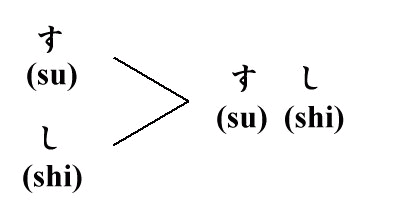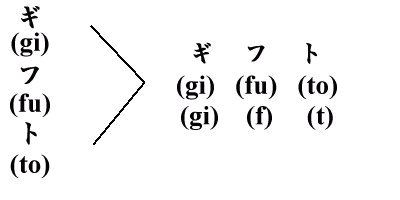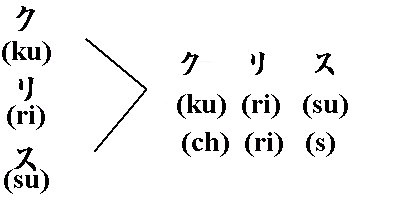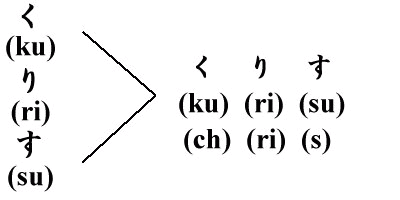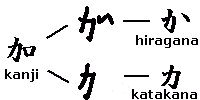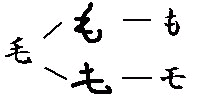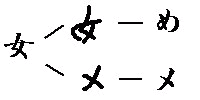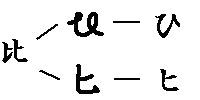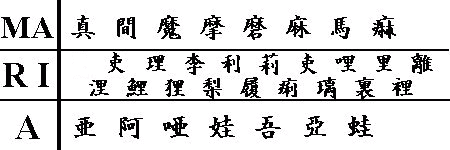|
The Japanese writing system utilizes three different sets of characters called hiragana, katakana and kanji.
This is an example of a simple Japanese sentence that includes all three types of characters. It says"I played tennis with John yesterday."
Can you tell how many hiragana, katakana and kanji are used in the sentence? ANSWER hiragana: F,J,K,L,M,N katakana: C,D,E,G,H,I kanji:A,B Hiragana and katakana are merely phonetic symbols composed of mostly consonant-vowel pairs, but also characters representing the 5 Japanese vowel sounds and the consonant 'n'. Just like (well not exactly but...) A, B, C, D, they are combined to make words. (See below) Unlike kanji, each symbol (character) by itself does not carry any meaning.
Hiragana and katakana have identical sets. In other words, for each hiragana, there is matching katakana. Then how do we differentiate the two? As mentioned above katakana are used mainly for foreign loan words which include NAMES OF PEOPLE FROM FOREIGN COUNTRIES. Words like table, soccer, video, light, France, juice, poster, rope, Josh,etc are also written in katakana, but with the percentage those words take up in the entire Japanese language, frequency of the use of katakana is naturally very low. If you take any reading material (books, papers, magazines), chances are that most of the characters you see are either hiragana or kanji. So if you are to have your name translated into Japanese, katakana is to be used. However, there is always an element of fun in writing words in hiragana that are supposed to be written in katakana. I personally like the way foreign names look in hiragana, For example the name "Chris" would look like this in katakana.
This is the hiragana version of "Chris"
As you might know by now, it is quite simple and easy to have your name translated into hiragana or katakana. All that has to be done is to find hiragana or katakana that sound CLOSE to your name.(BUT please keep in mind that the minute your name is translated into Japanese, it would no longer be your name, it would be the "Japanese-ized" version of your name because of phonetic reasons mentioned below by my friend.) However having your name translated into kanji would be a little different. Please continue on to my friend's article. Written by John Pasden.(Click here to visit his website.) Most modern linguists will tell you that there is really no such thing as a "difficult language" or an "easy language". Every language has different linguistic properties that makes it unique, but in the end, everything balances out, more or less. While this might be true for spoken language, it is not true for written language. Written language is a technology created by humans, and between writing systems there can exist varying degrees of complexity. Written Japanese is universally recognized as one of the most complex writing systems on this planet. When the Japanese encountered the Chinese in the 7th century A.D., they had no recognizable writing system. The Japanese quickly proceeded to learn Chinese along with its writing system, and, over time, Chinese characters began to be applied to native Japanese words. In addition, Chinese words were being adopted into the Japanese language in huge numbers.* Furthermore, to facilitate the learning of Chinese pronunciation, Japanese (male) scholars developed a phonetic syllabary (composed of mostly consonant-vowel pairs, but also characters representing the 5 Japanese vowel sounds and the consonant 'n') by extracting a simple element from common Chinese characters with well-known pronunciations. The resulting syllabary is known as "katakna." Meanwhile, the upper-class women of the Heian period had a lot of time on their hands and took to writing. It was not lady-like for women to study Chinese, but they did learn some characters and would use the phonetics of these characters to write in Japanese. The women would abbreviate whole characters in a soft, flowing style. This eventually resulted in another, separate syllabary representing exactly the same sounds as katakana called "hiragana". It is interesting to compare the hard, angular katakana developed by the men with the soft graceful curves of the women's hiragana.
Modern Japanese incorporates all 3 of these elements. The full Chinese characters, which, in general, look identical to what the Chinese still use today, are called "kanji" by the Japanese. This word has been translated as "Chinese characters", but it is simpler to call them kanji because the Chinese have their own characters, which do have some differences, and the Japanese have fully adopted kanji as their own. Almost all kanji can be pronounced the "Chinese way" ("on-yomi" in Japanese), based on the pronunciation of the character by the Chinese at the time of adoption. In addition, they can be pronounced the "Japanese way" ("kun-yomi"), because native Japanese words were assigned Chinese characters to represent them at the original time of adoption of the writing system. Some kanji have multiple on-yomi, some have multiple kun-yomi, and some have both multiple on-yomi and multiple kun-yomi. In modern written Japanese, kanji are used for most nouns and verbs. Hiragana is used largely for grammar (conjunctions, conjugations, etc.), though many Japanese words have no kanji (or at least no kanji that is still used) and are always written in hiragana. Katakana is used to write foreign loan words such as names of many countries, computer terminology, and names of foreigners. But hiragana and katakana are also used to indicate the reading of a kanji that the reader may not know. This is done for very difficult, obscure kanji in the newspaper as well as for Japanese children learning kanji in school. Sound complicated? It is. Japanese schooling is quite an ordeal. Students study kanji all the way through high school and often on into college. Yet somehow the literacy rate in Japan is high. So how do Japanese know how to read a kanji? It's all in context. A kanji's reading can be determined based on what surrounds the kanji: nothing, certain hiragana, or other kanji. All these different contexts for each kanji and the resulting reading must be memorized. And an educated Japanese may have all these various context-dependent readings of some 5,000 kanji memorized! So how do you write your name in kanji? Many Japanese will tell you you can't. Katakana is for foreign names, and that's what you are to use. They might not even like you using hiragana to write your name, because hiragana is for what is distinctly Japanese. So to use kanji, the heart of one of the world's most complicated writing systems, to write your simple foreign name would seem unthinkable... but you can. But it isn't easy! There is a rigid set of phonetic constraints on the pronunciation of Japanese. No word can end in any consonant except 'n'. Consonants cannot occur in clusters without intervening vowels. Many of the vowel sounds in English do not exist. There is no 'v' and no 'r' sound. The list goes on. The result is that in Japanese, English pronunciation is APPROXIMATED. Words that end in consonants in English have to end in vowels in Japanese. "Matt" becomes "Matto" and "Adam" becomes "Adamu". V's become B's, and R's are swept into the 'l'/'r' sounds employed by the Japanese language. The end result is a name that, when pronounced correctly the Japanese way, often sounds more Japanese than anything else to the foreigner who has just had his name "approximated". But the new "Japanese-ized" name has now been broken into Japanese syllabic units which can then be assigned kanji. Any given syllabic unit or even many combinations of syllabic units will usually have multiple readings in Japanese (with the exception of 'n', which is never by itself the reading for a kanji). Usually on-yomi (Chinese reading) are used because Japanese readers will usually pronounce an unfamiliar kanji compound based on the on-yomi for those kanji.** Take the name "Maria" for example. It is atypical because it fits neatly into Japanese syllabic units without approximation: Ma - ri - a Now, you could find readings for each syllable, choose your 3 kanji, and have a 3-kanji compound name.
You have a kanji version of "Maria" A couple of examples
Theoretically, though, you could also try: Ma ri - a (2 kanji) Ma - ri a (2 kanji) Ma ri a (1 kanji) The more combining you do, the less your chances will be that there is a corresponding kanji. In this case, the 3-kanji compound is pretty much your only option. It is quite a fun game to try to find kanji with agreeable meanings, but you can really come up with some interesting results. Unless you're well-versed in the Japanese language, though, you'll probably need the help of a native.(meaning my friend Junya!) Good luck! * The influx of Chinese vocabulary into the Japanese language along with the Chinese method of writing is similar to the effect the Roman empire had on the languages of its territories. ** Continuing the Roman analogy, complex multiple-kanji compounds are pronounced the Chinese way in much the same way as we use words of Latin origin in English to sound sophisticated or scientific. |




